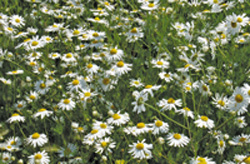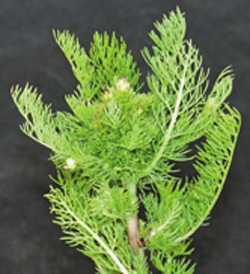
Features
Agronomy
Other Crops
Biological control agents for weeds
An important tool in managing the battle against invasive weeds.
November 29, 2007 By Donna Fleury
Weed management continues to get more complex and challenging across western
Canada. As concerns over invasive weeds, herbicide resistance and changing weed
regimes rise, incorporating as many tools as possible into weed management strategies
is important.
Biological control agents are one of the tools that can help reduce populations
of invasive weeds and slow their spread into crop and pasture lands. Biological
control uses a weed's natural enemies such as arthropods (insects, mites and
their relatives), bacteria or fungi to reduce or control populations. Classical
bio-control involves the release of a relatively small number of control agents,
usually insects, to suppress weed populations. The control agents are regulated
under Canada's Plant Protection Act and administered by Agriculture and Agri-Food
Canada's Canadian Food Inspection Agency (CFIA). Insects for scentless chamomile
and leafy spurge are some of the classical bio-control agents currently available
for use in western Canada.
 |
| Seed weevil on scentless chamomile. Photos Courtesy Of Alec McClay. |
Discovery, research and release of biological control
agents
Researchers at Agriculture and Agri-Food Canada's (AAFC) research centre in
Lethbridge, Alberta, continue to work on finding suitable classical biological
control insect agents for release in Canada. "Our basic initial research
is done overseas to identify and test potential biological control agents,"
says research scientist Dr. Rose De Clerck-Floate. "Our partner, Cabi Bioscience,
has a number of professional entomologists who travel all over Europe and into
parts of Russia to find potential control agents." These areas have the
best match climatically and where many of our serious invasive weeds have come
from, usually arriving here without their natural enemies.
"We continue exploring for new agents, but it is challenging," explains
De Clerck-Floate. "Some weeds and systems are really hard to crack because
there may not be many insects to choose from that feed on the weed overseas,
or we find we're looking in the wrong places, or we have difficulty in finding
agents that will be effective. We're concerned with not only finding effective
agents, but they must also be safe agents that aren't going to attack other
species." Canada thistle is a good example of how challenging the process
can be. "Canada thistle is a tough one because it's closely related to
other native thistles, and any agents that we're finding that feed on Canada
thistle, will likely feed on our native thistles as well."
Control of yellow toadflax is one of the current research priorities. "We've
found a couple of agents, in particular some weevils that look promising, but
we're still in the early stages of research," says De Clerck-Floate. As
part of the initial research process, a number of native plants closely related
to both yellow toadflax and Dalmatian toadflax (another introduced weed targetted
for bio-control) are sent overseas for testing. "We also have a new, state-of-the-science
containment facility at the Lethbridge research centre that allows us to do
some of the testing here in Canada," adds De Clerck-Floate. "We have
to complete thorough testing before we can petition for release."
Once safe biological control agents are identified, there is an experimental
stage to see if the agents will survive Canadian winters, and to determine if
they will be effective. "We need to determine whether or not the agents
can reach high enough numbers to have an impact on the weeds," explains
De Clerck-Floate. "We're working with living organisms, so it takes a while
for them to get established. We do have a wonderful track record, with about
one-third of the agents released being effective." The whole testing process
for one agent can take up to 10 years.
Once the control agents are established, AAFC hands them off to others for
propagation and distribution, such as provincial departments, agricultural districts,
or companies such as McClay Ecoscience. "We do have one pilot project where
we are working directly with ranchers to develop a process for them to propagate
and distribute control agents for hound's tongue in order to speed up the process,"
says De Clerck-Floate. "We developed a test method to farm the insects
by growing the weeds as a crop and seeding insects into the crop."
After two years, the numbers of the control agents were high enough for a massive
harvest and shipment of the control agents to partner ranchers, landholders
and land managers. "This process worked quite well, and now this proof
of concept is available for a similar process for other control agents. It may
also work for agents in a crop situation if we can also find agents that work
well in crops.
 |
| Scentless chamomile plants in bloom. |
"With a lot of our programs, we work across the border with the US, so
most of our weed bio-control consortia include Canadian and American researchers
and stakeholders who work together to fund overseas work for exploration and
testing," explains De Clerck-Floate. "Petitions for release of bio-control
agents are reviewed on both sides of the border and CFIA will take all of the
information into consideration when making a final decision for release in Canada."
Some of the other biological research work underway continues on hound's tongue,
toadflax and hawkweed.
Two successful biological control insect agents for
scentless chamomile
Biological control for scentless chamomile (Matricaria perforata), a
serious weed problem in some areas, is one of the success stories. There are
two biological control agents currently available for controlling scentless
chamomile, the scentless chamomile gall midge (Rhopalomyia tripleurospermi)
and the scentless chamomile seed weevil (Omphalapion hookeri).
"Although scentless chamomile is often found growing around field margins
or slough areas, infestations can get out of control and we are seeing whole
fields with fairly serious problems," says Dr. Alec McClay of McClay Ecoscience
in Sherwood Park, Alberta. "We've seen some fairly heavy field scale infestations
in canola and flax fields, particularly in east-central Alberta and in the Peace
River areas."
Biological control can be quite successful in non-crop situations by reducing
weed populations. However, it has been less successful in annual crops. "If
you've got a crop field with a heavy population of scentless chamomile, then
it's probably better to look at chemical or cultural control," explains
McClay. It is difficult for biological control agents to build up and persist
in the crop environment where they are subject to cultivation, spraying and
other types of disturbance. "However, it is important to consider biological
control in non-crop areas to help reduce the populations and prevent the spread
to crop areas." Roadways, utility and other rights-of-way, waterways, shelterbelts
and range and pasture lands are good locations.
"The key to successful release is selecting a suitable site for establishment,"
says McClay. "Successful biological control requires an undisturbed site
where cultivation, spraying and other types of weed control are not used."
In terms of timing, scentless chamomile gall midge are typically released in
early to mid summer, although releases as late as August can result in good
establishment. The gall midge spreads fairly rapidly, and one release per 640
acres is usually enough to get the population established. Scentless chamomile
seed weevils are usually released in either early summer or fall. They spread
less quickly than the gall midge, requiring one release per 160 acres.
"Both biological control agents survive very well in western Canada,"
says McClay. "Around Edmonton, there are quite good populations of both
the gall midge and the seed weevil building up, and even in areas where there
haven't been previous releases." When planning a release, determine if
previous releases were done, and assess whether sufficient numbers are already
there because there is no point doing a release if the populations are already
established.
 |
| Midge gall on scentless chamomile. |
"As long as a good site has been selected, the agents should persist and
build up over time," explains McClay. "Normally there isn't a need
for repeat releases, unless something goes wrong at a site, such as chemical
control." McClay also reminds growers that they are still subject to the
Provincial Weed Control Act. If they have received a weed notice for serious
infestations, they should check with their local agricultural fieldsman to find
out if biological control is a sufficient response to that weed notice.
McClay Ecoscience has both the scentless chamomile seed weevil and gall midge
currently available. The cost is $200 per release for each agent. "One
other agent that will be made available is a mite for control of field bindweed,"
says McClay. "There are a few sites around Medicine Hat with successful
populations, and I'm planning to start rearing these agents and make them available
next spring." McClay plans to continue making other agents available as
they become ready for release. For more information, go to: www.mcclay-ecoscience.com
Both De Clerk-Floate and McClay believe that biological control can be a successful
option, but caution that it is a gradual process. "It's important to look
at weed control and weed management as a total strategy, which includes prevention
of further spread of weeds, and control of weeds whether using chemicals or
bio-control agents," says De Clerck-Floate. "The key to biological
control is to keep an open mind because it is a longer-term strategy,"
adds McClay. "It's not the solution to all weed control problems in itself,
but the sooner we get started, the sooner we will see results."